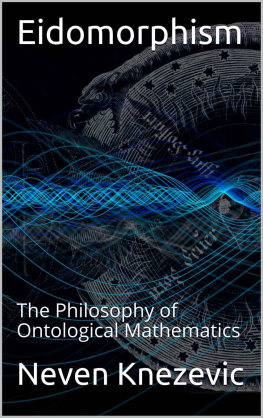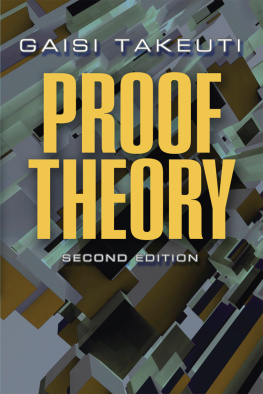
Gdels Proof
Nagel and Newman accomplish the wondrous task of clarifying the argumentative outline of Kurt Gdels celebrated logic bomb.
The Guardian
A little masterpiece of exegesis.
Nature

Routledge Classics contains the very best of Routledge publishing over the past century or so, books that have, by popular consent, become established as classics in their field. Drawing on a fantastic heritage of innovative writing published by Routledge and its associated imprints, this series makes available in attractive, affordable form some of the most important works of modern times.
For a complete list of titles visit
www.routledgeclassics.com
First published 1958
by Routledge
First published in Routledge Classics 2005
by Routledge
2 Park Square, Milton Park, Abingdon, Oxon, OX14 4RN
Simultaneously published in the USA and Canada
by Routledge
711 Third Avenue, New York, NY 10017
Routledge is an imprint of the Taylor & Francis Group
1958 Ernest Nagel and James R. Newman
Typeset in Joanna by RefineCatch Limited, Bungay, Suffolk
All rights reserved. No part of this book may be reprinted
or reproduced or utilized in any form or by any electronic,
mechanical, or other means, now known or hereafter
invented, including photocopying and recording, or in
any information storage or retrieval system, without
permission in writing from the publishers.
British Library Cataloguing in Publication Data
A catalogue record for this book is available from the British Library
Library of Congress Cataloging in Publication Data
A catalog record for this book has been requested
ISBN 0-415-35528-1
to Bertrand Russell
CONTENTS
ACKNOWLEDGMENTS
The authors gratefully acknowledge the generous assistance they received from Professor John C. Cooley of Columbia University. He read critically an early draft of the manuscript, and helped to clarify the structure of the argument and to improve the exposition of points in logic. We wish to thank Scientific American for permission to reproduce several of the diagrams in the text, which appeared in an article on Gdels Proof in the June 1956 issue of the magazine. We are indebted to Professor Morris Kline of New York University for helpful suggestions regarding the manuscript.
1

INTRODUCTION
In 1931 there appeared in a German scientific periodical a relatively short paper with the forbidding title Uber formal unentscheidbare Stze der Principia Mathematica und verwandter Systeme (On Formally Undecidable Propositions of Principia Mathematica and Related Systems). Its author was Kurt Gdel, then a young mathematician of 25 at the University of Vienna and since 1938 a permanent member of the Institute for Advanced Study at Princeton. The paper is a milestone in the history of logic and mathematics. When Harvard University awarded Gdel an honorary degree in 1952, the citation described the work as one of the most important advances in logic in modern times.
At the time of its appearance, however, neither the title of Gdels paper nor its content was intelligible to most mathematicians. The Principia Mathematica mentioned in the title is the monumental three-volume treatise by Alfred North Whitehead and Bertrand Russell on mathematical logic and the foundations of mathematics; and familiarity with that work is not a prerequisite to successful research in most branches of mathematics. Moreover, Gdels paper deals with a set of questions that has never attracted more than a comparatively small group of students. The reasoning of the proof was so novel at the time of its publication that only those intimately conversant with the technical literature of a highly specialized field could follow the argument with ready comprehension. Nevertheless, the conclusions Gdel established are now widely recognized as being revolutionary in their broad philosophical import. It is the aim of the present essay to make the substance of Gdels findings and the general character of his proof accessible to the non-specialist.
Gdels famous paper attacked a central problem in the foundations of mathematics. It will be helpful to give a brief preliminary account of the context in which the problem occurs. Everyone who has been exposed to elementary geometry will doubtless recall that it is taught as a deductive discipline. It is not presented as an experimental science whose theorems are to be accepted because they are in agreement with observation. This notion, that a proposition may be established as the conclusion of an explicit logical proof, goes back to the ancient Greeks, who discovered what is known as the axiomatic method and used it to develop geometry in a systematic fashion. The axiomatic method consists in accepting without proof certain propositions as axioms or postulates (e.g., the axiom that through two points just one straight line can be drawn), and then deriving from the axioms all other propositions of the system as theorems. The axioms constitute the foundations of the system; the theorems are the superstructure, and are obtained from the axioms with the exclusive help of principles of logic.
The axiomatic development of geometry made a powerful impression upon thinkers throughout the ages; for the relatively small number of axioms carry the whole weight of the inexhaustibly numerous propositions derivable from them. Moreover, if in some way the truth of the axioms can be establishedand, indeed, for some two thousand years most students believed without question that they are true of spaceboth the truth and the mutual consistency of all the theorems are automatically guaranteed. For these reasons the axiomatic form of geometry appeared to many generations of outstanding thinkers as the model of scientific knowledge at its best. It was natural to ask, therefore, whether other branches of thought besides geometry can be placed upon a secure axiomatic foundation. However, although certain parts of physics were given an axiomatic formulation in antiquity (e.g., by Archimedes), until modern times geometry was the only branch of mathematics that had what most students considered a sound axiomatic basis.
But within the past two centuries the axiomatic method has come to be exploited with increasing power and vigor. New as well as old branches of mathematics, including the familiar arithmetic of cardinal (or whole) numbers, were supplied with what appeared to be adequate sets of axioms. A climate of opinion was thus generated in which it was tacitly assumed that each sector of mathematical thought can be supplied with a set of axioms sufficient for developing systematically the endless totality of true propositions about the given area of inquiry.
Gdels paper showed that this assumption is untenable. He presented mathematicians with the astounding and melancholy conclusion that the axiomatic method has certain inherent limitations, which rule out the possibility that even the ordinary arithmetic of the integers can ever be fully axiomatized. What is more, he proved that it is impossible to establish the internal logical consistency of a very large class of deductive systems elementary arithmetic, for exampleunless one adopts principles of reasoning so complex that their internal consistency is as open to doubt as that of the systems themselves. In the light of these conclusions, no final systematization of many important areas of mathematics is attainable, and no absolutely impeccable guarantee can be given that many significant branches of mathematical thought are entirely free from internal contradiction.
Next page














